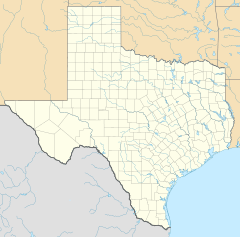Larissa, Texas facts for kids
Quick facts for kids
Larissa, Texas
|
|
|---|---|
| Country | |
| State | |
| County | Cherokee |
Larissa is a small, unincorporated community in Cherokee County, Texas, United States. An unincorporated community is a place that does not have its own local government. Larissa is located west of U.S. Highway 69. It is found off Farm to Market Road 855. The community is about halfway between Jacksonville and Bullard. Larissa is also about 20 miles northwest of Rusk, which is the county seat.
Contents
History of Larissa
Early Settlement and Conflict
Larissa was first settled by families like the Killoughs, Woods, and Williams. These settlers moved to the area in 1837 from Alabama. They began building homes and clearing land. However, this land was also claimed by the Cherokee Indians.
A year before, a treaty had set aside this land for the Cherokee. This treaty was signed by Sam Houston, a key figure in Texas history. But the government of the Republic of Texas did not approve the treaty. This made the Cherokee very upset.
More Anglo settlers kept moving into the area. This increased the tension between the settlers and the Cherokee. By 1838, there were worries about conflict. Some Cherokee and even some people loyal to Mexico were thought to be working together.
Because of this growing unrest, the Killough family and their friends went to Nacogdoches for safety. Cherokee leaders agreed to let them return to harvest their crops. But on October 5, 1838, a group of Cherokee attacked the settlement. Most of the Killough group, eighteen people in total, were killed or taken. Those who survived fled to a nearby fort. This event is known as the Killough Massacre.
New Beginnings and Growth
After the massacre, new settlers did not arrive until 1846. This was after the Cherokee were moved from the area by Mirabeau B. Lamar, another important figure in Texas history. In 1846, Thomas H. McKee, a Presbyterian minister, led a group to the area. They settled near the old Killough compound. Their new settlement was first called McKee Colony.
Thomas McKee's son, T.N. McKee, later planned a townsite. He named the new town Larissa. This name came from an ancient Greek city known as a center of learning. The Larissa post office opened in 1847. A Masonic lodge, a type of community organization, opened the next year.
In 1848, McKee built a one-room schoolhouse. It was first called Larissa Academy. In 1855, it received financial support from a church group. The school was then renamed Larissa College. It became an official college in 1856. The college grew to have a three-story building and two dormitories. It taught many subjects, including Latin, French, Spanish, chemistry, and physics. It even had an observatory with a powerful telescope. Larissa College was a co-educational school, meaning both boys and girls attended. However, they were taught in separate departments.
During the 1850s, a nearby community faded away. Much of its business moved to Larissa. By then, Larissa was a busy town with several stores, a salt works, and a church. This was Larissa's most successful period.
Decline and End
The Civil War greatly affected Larissa. It caused the college to close for a time. After the war, the college reopened but struggled to find students and teachers. By 1866, the church group stopped its financial support. They focused their efforts on Trinity University, which opened in 1869.
Larissa College was forced to close permanently by 1870. Its assets, including the telescope, were moved to Trinity University.
With the college gone, the town of Larissa began to decline. In 1872, the Great Northern Railway built its tracks eight miles south of Larissa. This meant the town was not on the main trade route. That same year, a meningitis epidemic, a widespread illness, affected many residents. Finally, in 1882, another railroad line was built three miles east of Larissa. This line might have helped the town, but it was too far away.
Many people who had stayed in Larissa moved to the new community of Mount Selman, which was on the railroad.
By 1990, very little remained at the old townsite of Larissa. There is a historical marker at the college site, placed in 1936. Another monument stands at the site of the Killough Massacre. There are also three cemeteries where many of the town's founders are buried. Today, the area is mostly a typical farming community.
Additional reading



